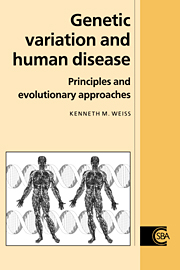Book contents
- Frontmatter
- Contents
- Frontispiece
- Preface: what is this book all about?
- Notational conventions used in this book
- List of abbreviations
- Part I Genes and their expression
- Part II Introduction to genetic epidemiology: inference from observational data
- Part III Evolution: the time dimension in populations
- Part IV Modification of the inherited genotype: the time dimension in individuals
- Afterwords: towards a unified general model
- References
- Index
Afterwords: towards a unified general model
Published online by Cambridge University Press: 05 June 2012
- Frontmatter
- Contents
- Frontispiece
- Preface: what is this book all about?
- Notational conventions used in this book
- List of abbreviations
- Part I Genes and their expression
- Part II Introduction to genetic epidemiology: inference from observational data
- Part III Evolution: the time dimension in populations
- Part IV Modification of the inherited genotype: the time dimension in individuals
- Afterwords: towards a unified general model
- References
- Index
Summary
Perhaps some day, an encyclopedic biochemist will accomplish the feat of including in a single map all the metabolic reactions in the biosphere … I will venture a prediction: it will indeed be a single map on which any point can be reached from any other point.
De Duve (1991)I chose Vesalius' classic figure of the human circulation for the Frontispiece of this book, because although it itself is not about genetics it is an appropriate metaphor for the genetic architecture that is typical of so many traits. The circulation is a redundant, anastamotic system that provides many vascular pathways to deliver blood to the same tissue, in a hierarchically structured way that has a few major arteries grading into many smaller arterioles and capillaries.
The spectrum of causation and the gradation of phenotypes
Biologists, perhaps like all people, seem to be divided into those who think qualitatively and those who think quantitatively, but the distinction is one of degrees rather than kind. In many instances phenotypes can be divided into categories, such as the presence or absence of a disease, for which associations with different genotypes can be documented generally by case-control studies or more precisely from mendelian patterns in families. For practical purposes we can say that some genotypes ‘cause’ a particular phenotype.
- Type
- Chapter
- Information
- Genetic Variation and Human DiseasePrinciples and Evolutionary Approaches, pp. 304 - 314Publisher: Cambridge University PressPrint publication year: 1993



